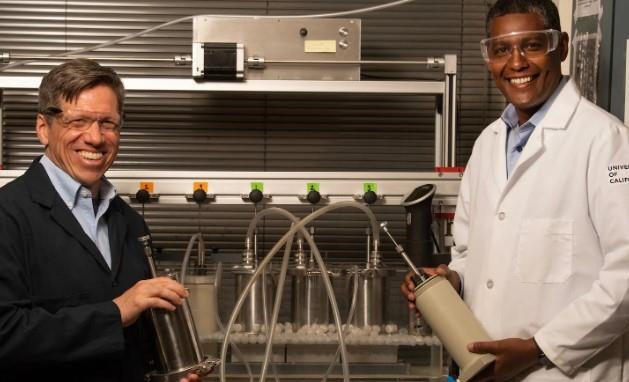By Clémentine Sicard
University of California, Davis, scientists are teaming up with UC Berkeley and UC San Francisco researchers on a $70-million donor-funded initiative that aims in part to cut climate change-causing emissions from cattle by using the genome-editing tool CRISPR on microbes in the cows’ gut.
Professor Ermias Kebreab, known for his innovative research using feed additives to reduce methane emissions, and Associate Professor Matthias Hess will collaborate with a world-renowned team at UC Berkeley: Professors Jennifer Doudna and Jill Banfield. Doudna won the 2020 Nobel Prize in chemistry for her work to develop CRISPR genome-editing technology. Earlier this year, Banfield became the first woman to win the van Leeuwenhoek Medal for her impact on the field of microbiology.
The groundbreaking health and climate initiative will be funded by TED’s Audacious Project, which provides donor support to encourage the world’s greatest changemakers to dream bigger. Announced today at the TED conference in Vancouver, “Engineering the Microbiome with CRISPR to Improve our Climate and Health” is the largest scientific award funded through the project to date.
“This cutting-edge initiative will harness the University of California’s research prowess to solve real-world problems in areas that affect us all: sustainability and health,” said University of California President Michael V. Drake. “I’m very pleased to see multiple UC entities working collaboratively to develop and deploy new technology for the public good. I’m grateful to our philanthropic partners for supporting impactful research that will change the world for the better.”
Partnering across the UC
Kebreab, an animal scientist and associate dean of global engagement at the College of Agricultural and Environmental Sciences, and Hess, a microbiologist, will serve as co-principal investigators at UC Davis to build on their successful work reducing methane emissions in livestock. In 2021, Kebreab gave a TED Talk on his breakthrough studies that reduced cow methane emissions by up to 82% with seaweed feed additives.
“Our campuses coming together on a project this big was a very organic process that came from many years of working together,” said Hess. “Donors are providing us a great opportunity for our team to bring variety of expertise that can benefit many different areas.”
Doudna and Banfield will lead the initiative at the Innovative Genomics Institute, or IGI, at UC Berkeley. They are combining their expertise to build a new toolkit to address global problems in climate and human health by applying CRISPR genome editing and genome-resolved metagenomics to complex microbial communities known as microbiomes.
Dysfunctions or irregularities in human microbiomes can impact health issues, including asthma. UCSF’s part in the research initiative will be led by Professor Sue Lynch, director of the UCSF Benioff Center for Microbiome Medicine, who will be applying the genome editing strategies to help prevent and treat childhood asthma.
“The Audacious Project incentivizes people to think big. Their donor community understands the power of each of our campuses drawing on our strengths in different ways to have a huge impact around the world,” said Kebreab.
Halting livestock methane emission at its source
Methane emitted in cow burps comes from gas-producing microbes in the gut. Engineering these microbes to produce less methane would help limit emissions before they are burped out.
“We’re trying to come up with a solution to reduce methane that is easily accessible and inexpensive, without restrictions or limitations, and that can be made available not only to California but globally,” said Hess.

Matthias Hess, left, and Ermias Kebreab, right, stand in front of a system that mimics a cow's rumen and allows Hess to study gas-producing microbes. (Gregory Urquiaga/UC Davis)
Hess and Kebreab’s vision is to one day deliver oral treatments to calves to intervene in their microbial systems at an early stage and reduce methane emissions for the rest of their lifetimes. While this is hypothetical for now, early studies offer hope it could eventually become a global practice.
“Engineering microbes directly where they live, without the need to isolate them, has not been done yet because there is no tool to do it. Now, with UC Berkeley, we will be developing those tools,” said Kebreab.
Hess and Kebreab’s labs are pairing up their complementary expertise: Hess will test the microbial tools and biocontainment strategies developed at the IGI in a lab setting, then he will deliver findings and results to Kebreab to apply to the animals out in the field.
Solving global challenges with donor support
Cattle are the top agricultural source of methane in the U.S. A third of human-influenced methane emissions are released by cows and other ruminant animals. Because methane doesn’t stay in the atmosphere as long as other gases like carbon dioxide, reducing emissions now will have a visible impact on the climate within the next decade. California has a mandate to reduce methane emissions 40% by 2030.
“We are thrilled to be working on this monumental research with collaborators who are on the mission of solving some of the world’s most pressing problems across climate and health,” said Helene Dillard, dean of the College of Agricultural and Environmental Sciences. “Answers to some of the biggest challenges can come from the smallest of things, and we are excited to see how this work with microbes can be part of the solutions.”
Kebreab and Hess note how donor support is crucial to such a large, cross-campus collaboration that is needed to solve big global challenges.
“This type of funding gives us a lot more room to explore things that we might not otherwise be exploring,” said Kebreab. “The project gives us freedom to communicate easily with the other faculty members. It really speaks to the power of the UC system as a whole.”
Source : ucdavis.edu